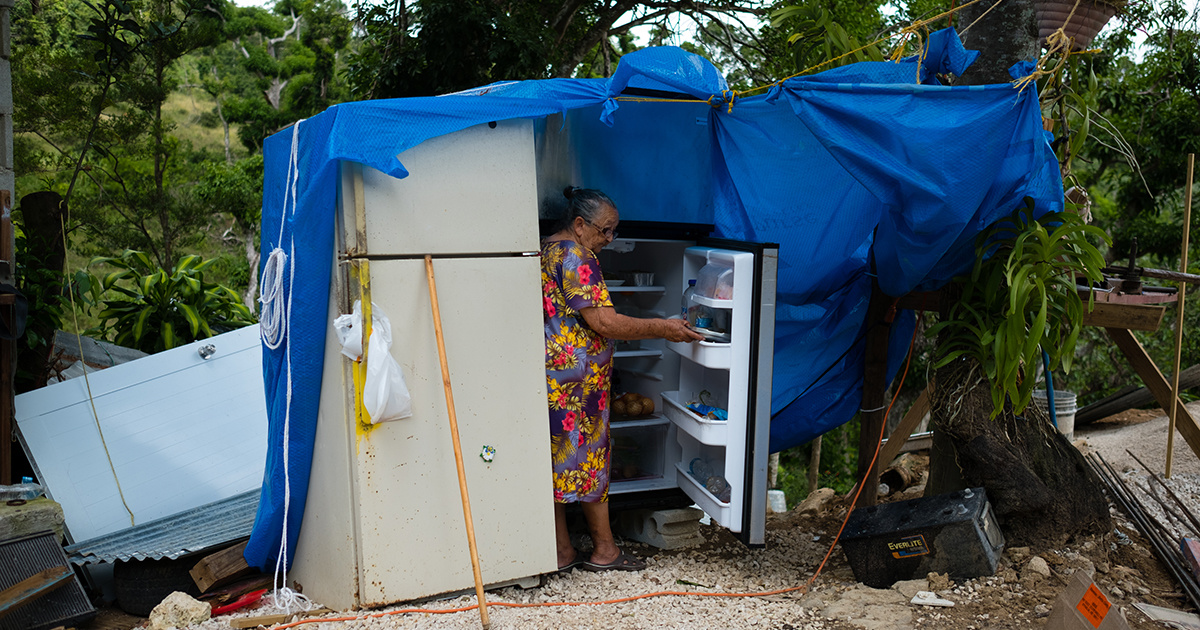
Trump Complains Puerto Rico Getting ‘Too Much’ Disaster Aid as More Than 1 Million Face Food Crisis

Petra Gonzalez, 85, spends hours of the day standing and walking on the potholed road that runs past her house. To get food to cook, Gonzalez has to hike to a refrigerator up the hill, covered only by a blue tarp,, Aug. 28 2018. Sarah L. Voisin / The Washington Post / Getty Images
By Jake Johnson
With more than a million U.S. citizens in Puerto Rico facing devastating food stamp cuts as Congress fails to provide necessary hurricane relief funding, President Donald Trump reportedly complained to Republican senators on Tuesday that the island is receiving “too much” aid — a position that was decried as both false and cruel.
“The president continues to show his vindictive behavior towards Puerto Rico and he continues to make the humanitarian crisis worse,” said San Juan Mayor Carmen Yulín Cruz. “He is ensuring that people don’t have food to put on the table.”
Trump’s remarks came during a private lunch with Republicans Tuesday, during which — according to the Washington Post — the president inflated the amount of aid Puerto Rico has received since Hurricane Maria and pushed lawmakers to limit funding to the island.
“At the lunch Tuesday, Trump rattled off the amount of aid that had been designated for other disaster-hit states and compared it with the amount allocated for Puerto Rico following the 2017 hurricane, which he said was too high,” the Post reported.
After claiming that Puerto Rico has received billion in federal aid — it is unclear where he got this number — Trump reportedly said “one could buy Puerto Rico four times over for billion.”
Puerto Rico Gov. Ricardo Rosselló responded with outrage to Trump’s reported comments in a statement late Tuesday.
“People from all over the nation, and the world, have witnessed the inequalities Americans face on the island,” Rosselló said. “The federal response and its treatment during these past months in the aftermath of Hurricane Maria is clear evidence of our second-class citizenship.”
“Mr. President: Enough with the insults and demeaning characterizations,” he added. “We are not asking for anything more than any other U.S. state has received. We are merely asking for equality.”
Trump’s complaint about aid to the storm-ravaged island comes as an estimated 1.3 million Puerto Ricans — including hundreds of thousands of children and elderly people — have had life-saving food aid cut amid inaction and obstruction from the White House and congressional Republicans.
“We just don’t have the money right now,” said Myrna Izquierdo, an administrator at a Puerto Rican health clinic that relies on food stamp funding. “It’s very hard. It is so unfair. That cut is going to kill us.”
The amount of reporting we have about the president's willful neglect of American citizens in Puerto Rico should be a bigger story, imo https://t.co/sSTj8CGRN9
— Astead (@AsteadWesley) March 26, 2019
Reposted with permission from our media associate Common Dreams.
- WATCH: Puerto Rico Planting 750,000 Trees to Defend Land From ...
- Study: Feds Response to Hurricane Maria Slower, Less Generous ...

 233k
233k  41k
41k  Subscribe
Subscribe 